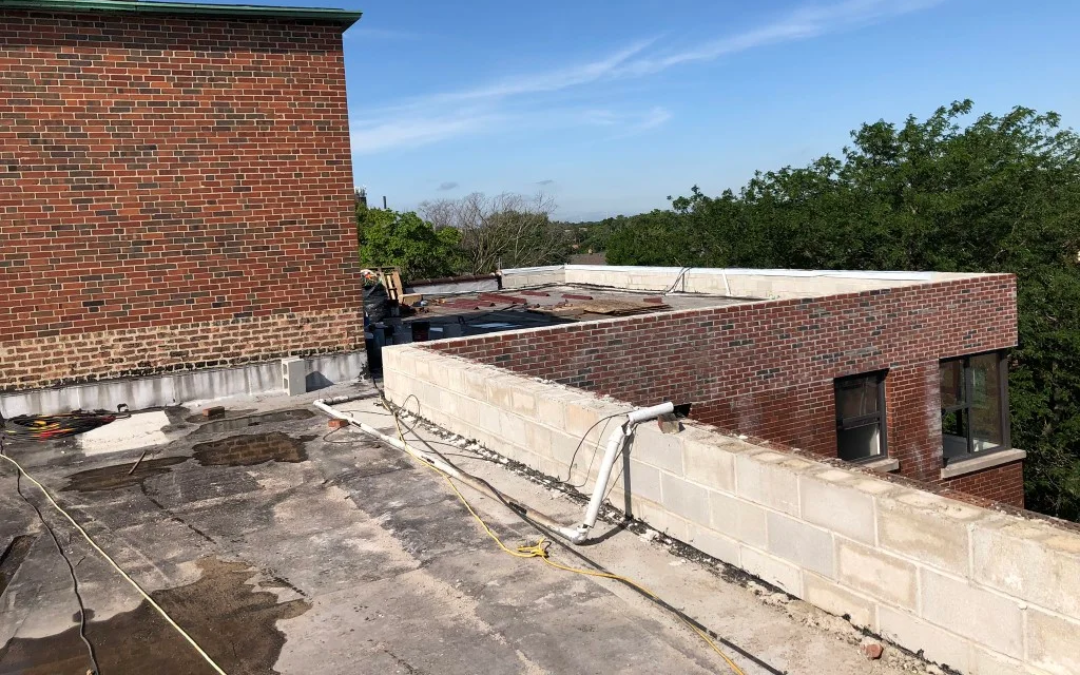Why Flat Roofs and Parapet Walls Are the Perfect Architectural Match

Have You Ever Noticed Flat Roofs and Parapet Walls?
Are you someone who ever glances up while walking through a neighborhood or a busy city street and notices the rooftops above you? If you have, chances are you have seen plenty of flat roofs. Look a little closer and you will also spot short walls running around the edges of those roofs. Those walls are called parapets. At first, they might not seem like much, but they are actually one of the smartest parts of the design. Flat roofs and parapet walls go together naturally, creating a setup that keeps buildings safe, sturdy, and nice to look at.
Did you know parapet walls have been around for centuries? They were first used to keep people safe and to protect buildings, and over time they also became a way to give rooftops a finished look. On this blog, we are going to talk about why flat roofs and parapet walls are such a perfect match. You will learn how they work together to improve safety, protect against weather, and even make a building look more polished. Once you see how useful they are, you will probably start noticing parapet walls everywhere.
Flat Roofs: A Modern Staple with Timeless Appeal
Flat roofs have been around since ancient civilizations, especially in warm and dry regions. Fast forward to today, and they remain one of the most popular roofing styles for both residential and commercial buildings.
Here’s why flat roofs continue to win people over:
- Extra space to use: You can set up a garden, a patio, or even a small seating area.
- Easy access for maintenance: They are easier to work on when you need to repair or install things like air conditioners or solar panels.
- Sleek, contemporary style: They have a clean and modern style that looks sharp and neat.
Parapet Walls: Small but Mighty
A parapet is the short wall you see around the edge of a flat roof. At first, it may look like just a decorative feature, but it has some very important jobs.
A parapet is the low wall that runs along the edge of a roof, balcony, or terrace. On a flat roof, it’s a game-changer. At first glance, it may seem like a small design choice, but its purpose runs much deeper.
- Safety first: Flat roofs are often used as functional spaces, but without a parapet, walking close to the edge could be risky. The wall acts as a built-in guardrail, keeping people safe.
- Protecting the roof system: High winds can lift at the edges of a roof membrane. A parapet reduces that risk by shielding vulnerable areas.
- Water control: Parapets help channel rainwater into drains instead of letting it spill directly over the edge. This prevents ugly streaks on walls and reduces long-term water damage.
- Fire protection: In tightly packed cities, parapets act as a fire barrier, helping stop flames from leaping from one building to another.
- Architectural finish: Let’s be honest, a flat roof without a parapet looks unfinished. That neat wall adds definition, balance, and polish to the building’s overall design.
It’s no surprise parapets are especially common with flat roofing systems. Sloped roofs don’t need them as much because gravity takes care of water runoff and steep edges naturally discourage access. Flat roofs, on the other hand, demand that extra line of defense.
Why They Work Best Together
Flat roofs and parapet walls are like two pieces that fit perfectly to complete the same puzzle. The flat roof gives you useful space and a modern look, while the parapet adds the safety and protection that makes that space practical. When the two are paired together, you get a roof system that is not only functional but also attractive. A parapet makes it safer to enjoy a rooftop without worrying about the edge, it helps the roof last longer by blocking wind and guiding water where it should go, and it even hides bulky equipment so the building looks neat and finished. Think of the flat roof as the main stage and the parapet as the frame around it that brings everything together.
Everyday Benefits You Might Not Notice
Most people do not really think about parapet walls, but they are always there doing their job without much attention. That safe and secure feeling you get when you are standing on a rooftop patio is because the parapet is there to protect you. The clean and balanced look along the edge of a building is also thanks to the parapet giving it a finished touch. Even the way rooftop machines like air conditioners or vents stay out of sight from the street is often because a parapet is hiding them. In simple ways like these, parapets make rooftops more comfortable, buildings look better, and skylines easier to enjoy, all while going mostly unnoticed.
Flat roofs are loved for the clean style they bring and the extra space they provide, while parapet walls add the safety, protection, and polish that make those roofs complete. On their own, each serves a purpose, but when they are combined, they create a design that is both practical and visually appealing. Together, they turn an ordinary roof into something that feels secure, looks finished, and stands the test of time. So the next time you notice a flat-roofed building, take a moment to look at that small wall running along the top. It may seem like a simple detail, but it is the quiet feature that ties the whole roof system together and makes the design work as well as it does.
Looking to improve your home or business with quality masonry work? Pyramid Pro Masonry Services is here to help, giving you reliable results and a team you can count on from start to finish.

0 Comments